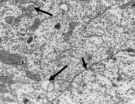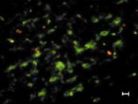(Press-News.org) The world's reefs are hotbeds of biological diversity, including over 4,500 species of fish. A new study shows that the ancestors of these fish colonized reefs in two distinct waves, before and after the mass extinction event about 66 million years ago that wiped out the dinosaurs.
Reef fish represent one of the largest and most diverse assemblages of vertebrates, according to Samantha Price, a postdoctoral researcher in the Department of Evolution and Ecology at UC Davis. Price is first author on a paper describing the work, published April 2 in the journal Proceedings of the Royal Society B.
The fossil record of reef fish is patchy, so Price and colleagues traced their ancestry by developing a comprehensive family tree of the major group of modern ocean fish, the acanthomorphs or "spiny-finned fish," and calculating the times when different groups migrated into or out of reef habitats.
The first wave of colonization occurred between 70 and 90 million years ago, before the end of the Cretaceous period, they found. At that time, most the world's reefs were built not by coral but by mollusks called rudists.
Rudists disappeared in the mass extinction at the end of the Cretaceous, 66 million years ago, and corals became the world's great reef builders. While the first-wave reef fish hung on to leave descendants in the present, a second wave of colonization took place as the world recovered from the extinction event.
The early wave of colonization began with lots of different-looking fish and over time there was an eventual filling of ecological niches accompanied by a decrease in colonization, Price said.
By about 50 million years ago, the fundamentals of modern coral reefs, including the ancestors of most major families, such as clownfishes and parrotfishes, were in place, Price said.
"If you were able to dive on a coral reef 50 million years ago, the fishes would seem familiar, you would recognize it as similar to a modern reef," she said.
INFORMATION:
Co-authors on the paper are Professor Peter Wainwright, UC Davis; Lars Schmitz, Claremont McKenna College; Christopher Oufiero, Towson University; Ron Eytan, Alex Dornburg and Thomas Near, Yale University; Wm. Leo Smith, University of Kansas; and Matt Friedman, University of Oxford. The work was funded by the National Science Foundation and the Natural Environment Research Council (U.K.).
Reef fish arrived in 2 waves
2014-04-10
ELSE PRESS RELEASES FROM THIS DATE:
CU researchers unraveling what's behind the sniffles, hoping for a treatment
2014-04-10
Scientists at the University of Colorado School of Medicine have shed light on one of the most common of ailments – the runny nose.
Your respiratory tract is under constant attack and the nose is the first line of defense. Often, especially as the weather warms, the assault comes from allergens, which cause the body to fight off a perceived threat. Infections, too, are a problem.
But millions of people get a runny nose and have difficulty breathing without an allergic attack or infection. What many people call the sniffles, scientists refer to as "non-allergic rhinitis."
Although ...
China looks to science and technology to fuel its economy
2014-04-10
Maintaining stability in the face of rapid change and growth, and proactively partaking in cooperative global ties in science and technology fields will be key in helping China become an innovation-based economy, according to Denis Simon, vice provost for International Strategic Initiatives at Arizona State University.
One of the world's leading experts on science, technology and innovation in China, Simon recently hosted an ASU conference that focused on the evolving role of science and technology in China's international relations.
Supplemented with strategic investments ...
Researchers looking to create new bone tissue generation technique
2014-04-10
UT Arlington and Texas Health Arlington Memorial Hospital are investigating whether bone grown from the body's own stem cells can replace traditional types of bone grafting.
The process, which has been successful in previous lab experiments, uses biodegradable polymer scaffolding material and bone morphogenetic protein, or BMP, which was inserted into the abdomen of mice to attract stem cells that in turn produced bone. BMPs are proteins known to promote bone growth. The research is detailed in a new paper, "Tissue Engineering Bone Using Autologous Progenitor Cells in ...
La Brea Tar Pit fossil research shows climate change drove evolution of Ice Age predators
2014-04-10
LOS ANGELES — Concerns about climate change and its impact on the world around us are growing daily. New scientific studies at the La Brea Tar Pits are probing the link between climate warming and the evolution of Ice Age predators, attempting to predict how animals will respond to climate change today.
The La Brea Tar Pits are famous for the amazing array of Ice Age fossils found there, such as ground sloths, mammoths, and predators like saber-toothed cats and powerful dire wolves. But the climate during the end of the Ice Age (50,000-11,000 years ago) was unstable, ...
Acupuncture normalizes brain structure and damaged neurons following heroin relapse
2014-04-10
Heroin abuse can damage many brain areas, including the pedunculopontine tegmental nucleus of the midbrain, the ventral tegmental area, and nucleus accumbens. Persistent use of heroin induced irreversible damage to the nervous system. To verify the relationship between acupuncture, neurotrophic factor expression and brain cell structural changes, a research team from Anhui University of Chinese Medicine in China established a rat model of heroin relapse using intramuscular injection of increasing amounts of heroin. During the detoxification period, rat models received acupuncture ...
Brainy courage of the rainbowfish
2014-04-10
The boldest black-lined rainbowfish are those that are born in the wild. Also more fearless are those that analyze information both sides of their brains. This is the conclusion of Australian researchers Culum Brown and Anne-Laurence Bibost from Macquarie University, in a study published in Springer's journal Behavioral Ecology and Sociobiology.
The preference to analyze and react to information with either the left or right hemisphere of the brain is called cerebral lateralization, and is widespread among vertebrates. Lateralization is seen in the preference of humans ...
Identified epigenetic factors associated with an increased risk of developing cancer
2014-04-10
In 10% of human tumors there is a family history of hereditary disease associated with mutations in identified genes. The best examples are the cases of polyps in the large intestine associated with the APC gene and breast cancer associated with BRCA1 and BRCA2 genes. In the remaining 90% of cases are believed to have an increased risk of developing cancer in relation to genetic variants less powerful but more often, for example, doubles the risk of having a tumor that lacks this small change, called polymorphism.
In the last decade, hundreds of studies have been conducted ...
Experts disagree on horses with incoordination
2014-04-10
A trip to the veterinarian may prove fatal to a horse, even if it is not necessary to put the animal down. In Europe if the horse is found to be ataxic, which is most often due to the disease 'wobbler syndrome', the horse is likely to be put down immediately. If a horse suffers from this disease, putting it down can be a necessity, as the animal can be dangerous to ride and handle. But now new research from the University of Copenhagen and the Royal Veterinary College in the UK shows marked disagreement among experts about when a horse is ataxic and severity of the ataxia. ...
Proof that antidepressants and breastfeeding can mix
2014-04-10
University of Adelaide researchers have found that women on antidepressant medication are more successful at breastfeeding their babies if they keep taking the medication, compared with women who quit antidepressants because of concerns about their babies' health.
These results have been presented this week at the 18th Perinatal Society of Australia and New Zealand (PSANZ) Annual Conference in Perth.
Using data from the Danish National Birth Cohort in Denmark, researchers in the University of Adelaide's Robinson Research Institute studied the outcomes of 368 women who ...
Special function of nestin+ neurons in medial septum-diagonal band of Broca in adult rats
2014-04-10
Dr. Yuhong Zhao and co-workers from Sun Yat-sen University in China explored the projection of nestin+ neurons to the olfactory bulb and the time course of nestin+ neurons in the medial septum-diagonal band of Broca in adult rats during injury recovery after olfactory nerve transection. These researchers observed that all nestin+ neurons were double-labeled with ChAT in the medial septum-diagonal band of Broca. Approximately 53.6% of nestin+ neurons were projected to the olfactory bulb and co-labeled with fast blue. A large number of nestin+ neurons were not present in ...



